Large Periwinkle (Vinca major)

Photo credit: Chris Evans, Illinois Wildlife Action Plan, Bugwood.org

Management Strategy
Squamish
Whistler
Pemberton
Vectors of Spread
ID Characteristics
General: Evergreen to semi-evergreen trailing perennial.
Flowers: Pinwheel-style flowers are pale blue to lavender, up to 5 cm wide. There are up to 4 flowers per stem, each with 5 petals.
Stems: Evergreen, tender, and hairless stems range from 25 to 50 cm long and form a trailing or spreading ground cover. Stems exude a milky latex when broken.
Leaves: Are shiny, dark green and grow in pairs along the stem, measuring 4 – 6 cm long. They are typically heart-shaped, but they can range from somewhat triangular to elliptic.
Seeds: Cylindrical pods grow up to 5 cm long, and release 3 to 5 seeds when dry.
Roots: Underground stems, which are also known as stolons.
Similar Species
Invasive
Small periwinkle (Vinca minor): There are two kinds of periwinkle, small (Vinca minor) and large (Vinca major). As the name suggests, the major difference between the two is the size of their leaves. V. major has slightly larger and broader leaves, that are in an oval or heart shape. V. minor has smaller, elongated leaves that are lance-shaped.
Learn more about the differences between small and large periwinkle here.

Small (or Common) Periwinkle (Vinca minor)
Exotic
Madagascar periwinkle (Catharantheus roseus): This plant is from the same family (Apocynaceae) as small and large periwinkle, and has similar-looking leaves and flowers. This plant can be distinguished from other periwinkle species by its pink flowers, and more upright stems. It typically grows in hotter climates, such as Madagascar or the southern US, and is not found in the Sea to Sky.

Native
Bunchberry (Cornus canadensis): This native plant has four-petaled white flowers.

Dave Powell, USDA Forest Service (retired), Bugwood.org
Habitat and Origin
Originally native to Eurasia and northern Africa, Large periwinkle was introduced to North America in the 1700s for ornamental and medicinal uses.
Large periwinkle thrives in many soil types, from well-drained to moist and from sand to clay. As it prefers partially shaded areas, large periwinkle commonly invades forest edges, clearings and roadsides.
How it Spreads
Large periwinkle reproduces primarily vegetatively. Propagation by seed is also possible, though this is uncommon as seeds are typically not viable. When large periwinkle spreads vegetatively, it does so through its stems rooting at the nodes as well as by spreading underground stems, called stolons.
Large periwinkle’s main vector of spread is the horticulture trade, as it is widely sold in garden centres and nurseries as a shade-loving ground cover. Moreover, the improper disposal of plant waste can aid its spread, as stem cuttings left on the ground can take root. Large periwinkle also spreads by stolons. Lastly, if the species is growing near water, seeds and fragments of large periwinkle can wash downstream and start new invasions.
Impacts
Ecological:
- Reduces biodiversity.
- Discourages the growth of native plants by forming extensive mats along the forest floor.
- Can lead to erosion when grown on riverbanks as it displaces native, deeper-rooted plants.
- Releases a biochemical that can prevent the germination and growth of other plant species, which may add to its competitive advantage (allelopathy).
- Reduces the amount of forage available to wildlife.
- Is a major host of plant diseases, like black root rot and gall.
Health:
- Toxic to humans and animals if ingested.
Stop the Spread
Large periwinkle is not yet found in the Sea to Sky region, but is found in neighbouring areas and may arrive here soon. The goal is to prevent Large Periwinkle introduction by focusing on education and awareness. If prevention fails, the goal will become immediate eradication following the proposed SSISC EDRR protocol.
Learn to identify large periwinkle: use the images presented in this profile page to learn how to identify this plant.
What to do if you spot it: You can report any periwinkle sighting by visiting our reporting page.
DO:
- Regularly monitor properties for infestations.
- Be PlantWise: avoid planting large periwinkle, no matter how well-contained its enclosure might seem.
- Ensure soil and gravel are uncontaminated before transport.
- Minimize soil disturbances and use seed mixes, or other non-invasive ground cover plants to re-vegetate exposed soil and resist invasion.
- Ensure plants (particularly flowering heads or root fragments) are bagged or covered to prevent spread during transport to designated disposal sites (e.g. landfill).
DO NOT:
- Don’t unload, park, or store equipment or vehicles in infested areas; remove plant material from any equipment, vehicles, or clothing used in such areas, and wash equipment and vehicles before leaving infested areas.
- DO NOT COMPOST!
Control
Mechanical Control:
- Hand-pull large periwinkle repeatedly as it appears; persistence is key.
- Try to remove all of the plant and its roots, and dispose of plant material appropriately.
- Mulch heavily or re-plant with non-invasive species after removal.
- “Matting” small infestations for 4- 6 months (covering with tarps) after they have been pulled may also be effective.
Chemical Control:
Foliar application of glyphosate to growing plants can be effective, especially as a follow-up to mechanical methods. Other effective herbicides include tricloplyr, imazapyr and 2,4-D. Mowing soon after herbicide application often improves control.
We recommend that any herbicide application is carried out by a person holding a valid BC Pesticide Applicator Certificate. Before selecting and applying herbicides, you must review and follow herbicide labels and application rates; municipal, regional, provincial and federal laws and regulations; species-specific treatment recommendations, and site-specific goals and objectives.
Biological Control:
While there are no biocontrol agents currently available in BC, large periwinkle is susceptible to fungal foliar disease.
Distribution in B.C.
Large Periwinkle Factsheet
Having trouble viewing the factsheet? Don’t worry, all the information is included on this page. You can also contact us with any questions.
Additional Resources
References
- California Invasive Plant Council, Vinca major
- Central Kootenay Invasive Species Society, Periwinkle
- Coastal Invasive Species Council, Periwinkle Species
- Global Invasive Species Database, Vinca major
- Invasive Species Compendium, Vinca major
- Invasive Species Council of BC, Common Periwinkle Factsheet
- Nature Gate, Lesser Periwinkle
- North Carolina Invasive Species Assessment
- UC Davis, Weed Control Handbook, DiTomaso, J.M., G.B. Kyser et al. 2013. Weed Control in Natural Areas in the Western United States. Weed Research and Information Center, University of California. 544 pp.
- US Department of Agriculture Fire Effects Information System, Vinca major, V. minor
- Washington State Noxious Weed Control Board, Periwinkle
- Whatcom County Noxious Weed Control Board, Periwinkle














